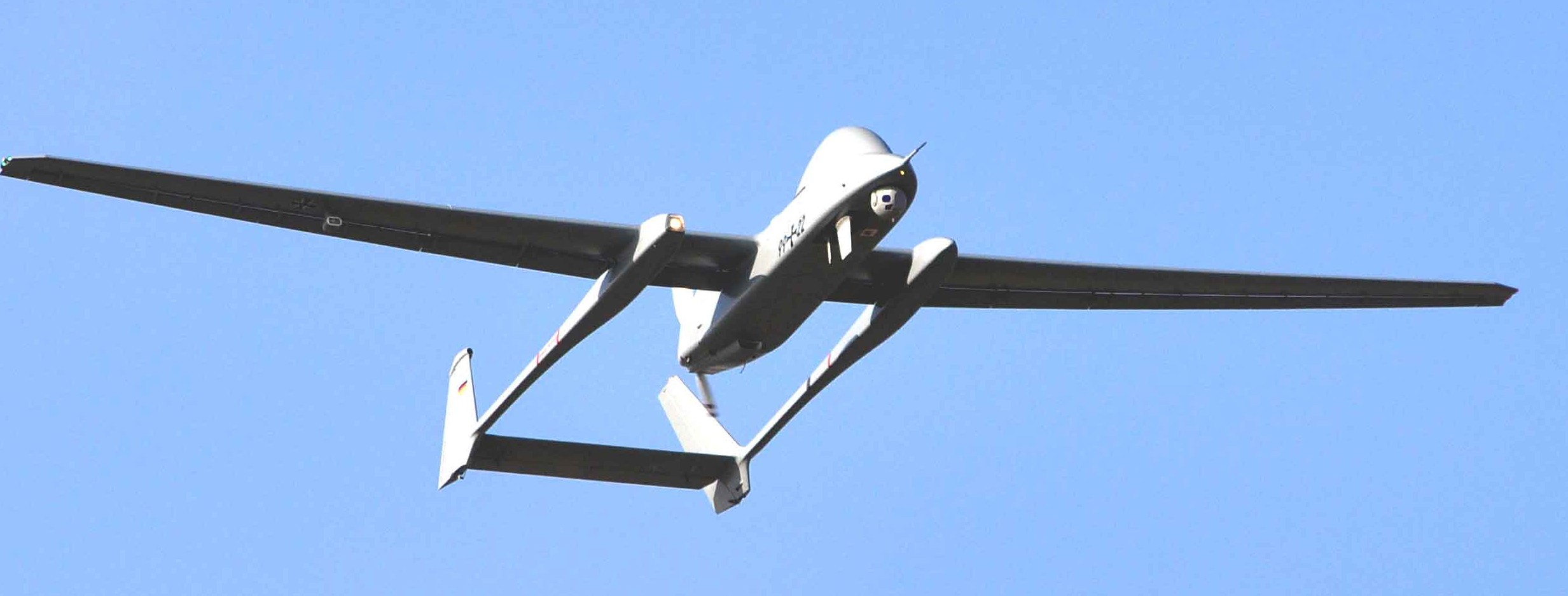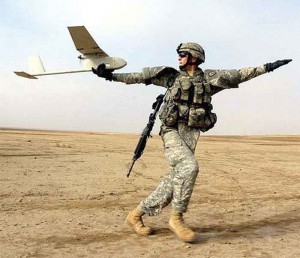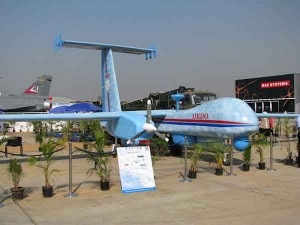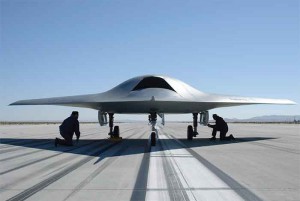The main attraction of military UAVs stems from the fact that their acquisition and training costs are far lower than those of combat jets. They can also be operated or stored at a fraction of the cost of manned aircraft. Neither do drones risk the life of a pilot nor are they subject to physiological limitations. They can remain airborne for prolonged periods – loitering at great height and striking or assisting strikes with devastating accuracy when an opportunity arises. On these and other counts, they are superior to fixed wing aircraft and cruise missiles. They will surely play a key role in most future conflicts.
It is only a question of time before militant groups and non-state actors begin to acquire and operate UAVs…
If there is one item that tops the list of must-haves for any modern military force, it is Unmanned Aerial Vehicles (UAV). A handful of countries produce them, most buy them. Some high-end Medium Altitude Long Endurance (MALE) options such as the iconic Heron UAVs manufactured by Israel Aerospace Industries (IAI) can even be rented. UAVs, popularly known as drones, have been around for decades. First used for battlefield reconnaissance, they now encompass practically every military application and a growing number of civilian ones.
Spreading Everywhere
Till about a decade ago, Israel and the United States led the pack when it came to UAV employment. They enjoyed a virtual monopoly on the use of unmanned technology. The US accelerated the production and operational use of UAVs after the 9/11 attacks in 2001. Soon, stories of spectacularly successful UAV strikes by US forces in Iraq and the Afghanistan-Pakistan theatre made military decision makers across the world sit up and take notice.
America still dominates the UAV, especially the Unmanned Combat Air Vehicle (UCAV) scene to a large extent. One in three US military aircraft is a UAV, and their number is rising. American UAVs now fly more hours than its manned strike aircraft. The US Air Force’s training programmes focus more on UAV pilots than on their manned counterparts. And the deep budget cuts that affect practically every weapons programme of the lone superpower seem to have left UAVs unscathed.
As for Israel, having wowed the world with unmanned systems in the Intelligence, Surveillance and Reconnaissance (ISR) role ever since the Yom Kippur War of 1973, it is still the favourite source of UAVs across the globe. Israeli companies such as Elbit, IAI and Aeronautics Defense are global leaders in UAV technology.
About 90 nations have drones that carry out surveillance either over their own territory or that of other countries. And unmanned systems constitute one of the fastest growing military aviation markets today. In November, Pakistan announced that it had operationalised two indigenous UAV designs – Burraq and Shahpar. Burraq can reportedly carry missiles and may be an improved version of the Chinese Rainbow CH-3 UCAV. In December, Nigeria unveiled the country’s first indigenous UAV, Gulma, produced by the Nigerian Air Force. The Philippines recently developed two micro-UAVs similar to AeroVironment’s RQ-11B Raven, which is possibly the most widely used UAV in the world.
American UAVs now fly more hours than its manned strike aircraft…
It is only a question of time before militant groups and non-state actors begin to acquire and operate UAVs.
Will India’s Efforts Succeed?
India’s defence forces currently import UAVs such as the Heron and the smaller Searcher tactical system from Israel. However, the Aeronautical Development Establishment (ADE), a subsidiary of the Defence Research and Development Organisation (DRDO), is working on a MALE UAV known as Rustom-2, which is expected to replace or supplement the Heron. It takes off and lands from a runway using a conventional undercarriage. It has a wingspan of 21 metres, an endurance of more than 24 hours, and a payload of 350 kilogrammes. Flying at an altitude of 35,000 feet, it will acquire real-time imagery from the battlefield and transmit it to a ground control station. An armed variant, the Rustom-C, may carry missiles and undertake both combat and surveillance missions.
An even more ambitious project is AURA – code name for an autonomous UCAV, being developed by the DRDO for the Indian Air Force. However, few details have been released. If the Rustom and AURA projects fructify they will greatly enhance the country’s unmanned warfare capability.
Unmanned Into Combat
So far only the US, UK and Israel are known to have launched missiles from UAVs, mainly to take out alleged terrorists. But sooner rather than later other countries are likely to follow suit. According to experts, at least 10 to 15 nations are trying to develop their own UCAVs including Russia, China, India and Iran. UCAVs afford greater range, manoeuvrability and payload capacity than manned strike aircraft because they dispense with life-support systems, flight controls, ejection seat even the cockpit. Most UCAVs are remotely controlled by a ‘pilot’ on the ground. However, future versions will be capable of fully autonomous missions with pre-programmed routes and target details, decision making ability, and capability to defend against air and ground threats.
Israeli companies such as Elbit, IAI and Aeronautics Defense are global leaders in UAV technology…
American UCAVs under development include Boeing’s privately-funded X-45 Phantom Ray and Northrop Grumman’s X-47B which could eventually replace some US Navy fighters. The X-47B, a technology demonstrator, is the only autonomous fixed-wing aircraft to have achieved a catapult take-off and arrested landing on an aircraft carrier, without human control. Its automatic landing system is capable of handling high speed and complex (different directions) winds. Northrop Grumman intends to develop the X-47B into an operational UCAV, ready for service by 2019.
Among a range of military UAVs being quietly developed by Russia are some strike versions. Last year, RAC MiG signed a research and development contract to build a UCAV based on its previous Skat design.
UK’s Royal Air Force is contemplating replacing up to 30 per cent of its fighter aircraft with UCAVs. Taranis, under development by UK’s BAE Systems, is one of the world’s largest UCAVs. It is a semi-autonomous stealthy device designed to fly intercontinental missions at supersonic speeds. This technology demonstrator is intended to prove the capability of unmanned systems to attack ground targets even in a hostile environment.
The nEUROn is an experimental UCAV being developed by six European companies led by France’s Dassault Aviation. It is currently under testing and Dassault will use its flight data to produce derived UCAVs featuring payloads and ranges similar to those of manned aircraft and with autonomous air-to-ground attack capability.
China is still playing catch up with the US and Israel in the development of UAVs. And it is pursuing its goal with steely determination. It already produces various types of UAVs ranging from hand-launched miniature models to large, long-range reconnaissance versions. A low-observable UCAV called ‘Li Jian’ (“Dark Sword” or “Sharp Sword”) flew for the first time in November last year. It resembles the US X-47B and potentially represents a major advance in Chinese unmanned expertise.
Stealth – An Essential
For all the stunning successes achieved by UAVs in operations, they are fairly fragile devices. Lacking the situational awareness of manned aircraft, they are vulnerable to electronic countermeasures that can render them useless simply by disrupting communications with their operators. Till now, they have mostly been employed in non-conventional conflict in “permissive” or “uncontested” airspace – where traditional anti-aircraft defences were limited or even absent. A relatively bulky and sluggish UCAV such as the General Atomics MQ-1 Predator would be a sitting duck even in moderately defended or “contested” airspace.
Lacking the situational awareness of manned aircraft, UAVs are vulnerable to electronic countermeasures…
Indeed, after the Lockheed SR-71 Blackbird, which used to carry out high-level reconnaissance while cruising at Mach 3, was retired in 1998, US ability to collect intelligence in heavily-defended areas or “denied” airspace has been considerably reduced.
That may change with the arrival of the new Northrop Grumman RQ-180, currently spoken about only in hushed whispers. It is a flying-wing with a wingspan larger than that of a Boeing 737. Probably the first in a series of new super-fast, super-stealth unmanned devices, it constitutes a major advance in combining stealth and aerodynamic efficiency – a daunting task at the best of times. It could be operational with the USAF as early as next year. It reportedly carries radio-frequency sensors such as Active Electronically Scanned Array (AESA) radar and passive electronic surveillance devices. It may execute electronic attack and strike missions. With the RQ-180, the USAF hopes to prove that UAVs incorporating low-observable technology still have the ability to counter new threats like low-frequency radar and penetrate even denied airspace.









This piece of writing is really a nice one it helps new internet people, who are wishing for blogging.